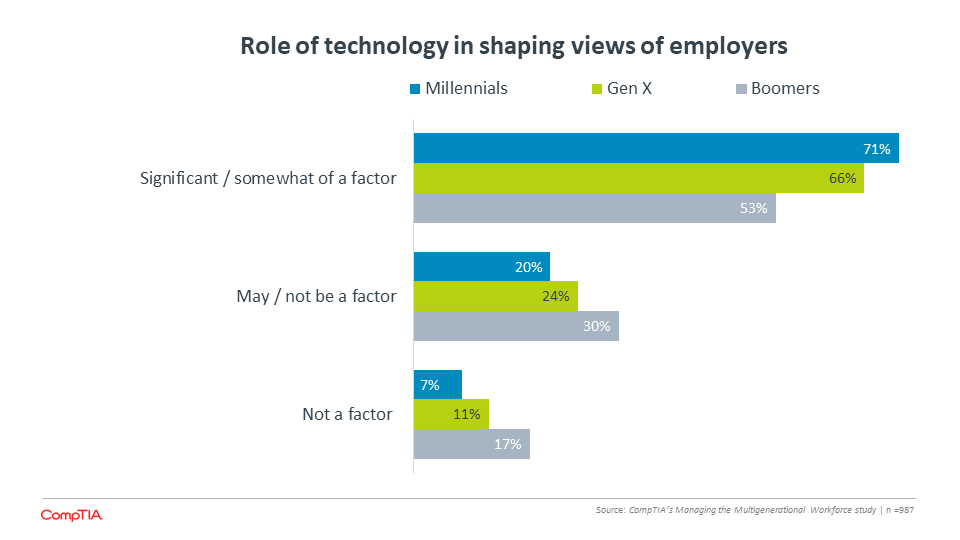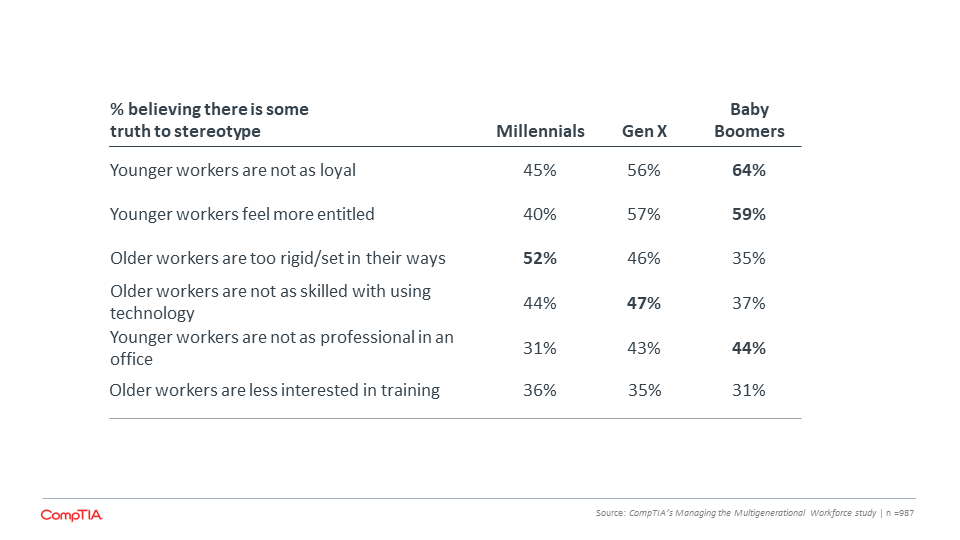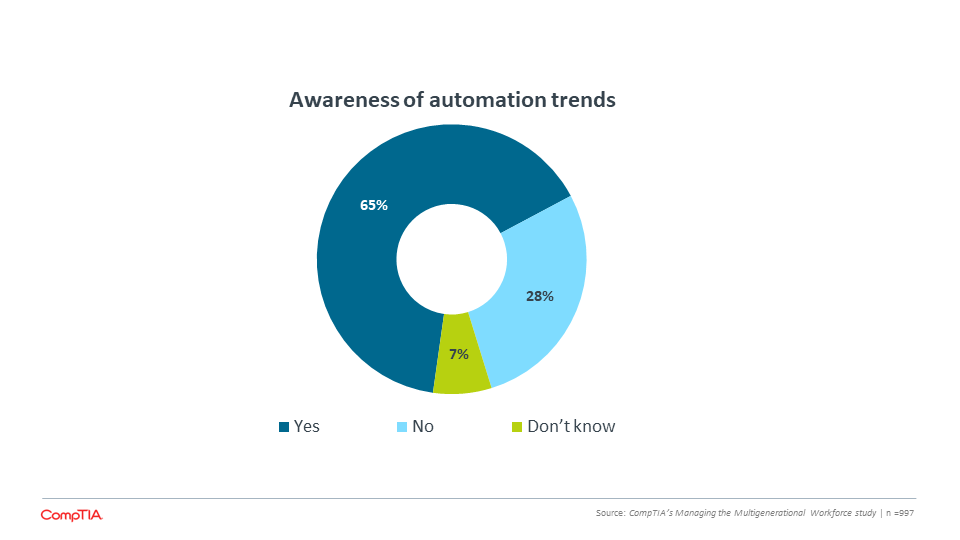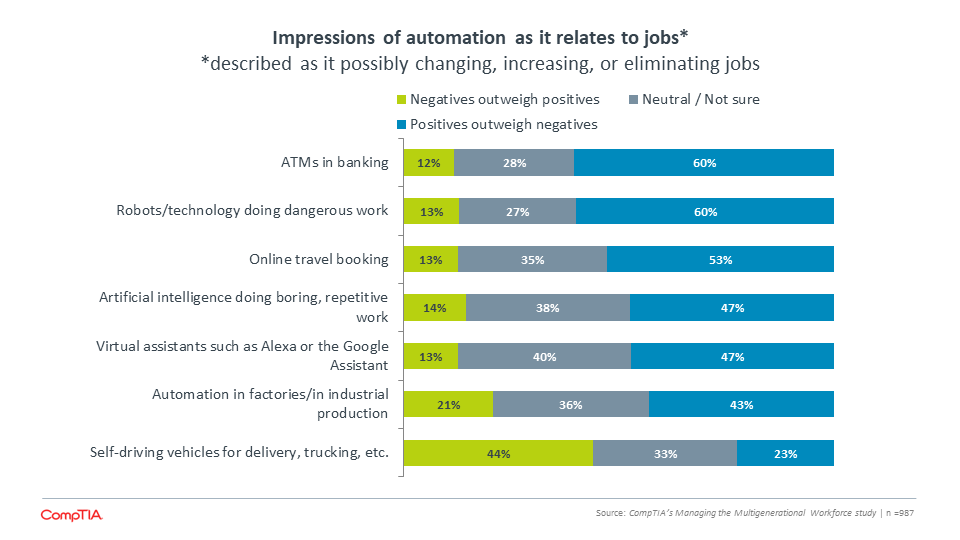T oday's workforce is undergoing a seismic shift in generational makeup, a change in basic composition that has serious management implications for corporations facing an employee base whose ages span a huge chasm – in many cases 40 years or more. For companies, managing across many age groups is no small feat when you consider the differences in skill sets, work habits, employer loyalty, training needs, and preferences for the type of IT tools they use. External market factors are also in play: the rapid pace of technological change, new ways information is shared and stored in the cloud, the advent of social media, and the impact of automation among other factors. The result? A workforce in flux.
Key Points
Majority of Millennials consider use of technology when evaluating current or future employers
A company’s technology capabilities plays an important role in attracting the best talent
especially for younger employees. The role of technology seems to be more of a factor today when compared to previous years – in 2015 and 2017, 65% and 67% of Millennials, respectively, reported technology being a factor in the employment
decision. Younger workers are more apt to feel their company is pushing the envelope, suggesting that they are taking greater advantage of technology being offered or are seeking out tech-savvy employers.
71% of millennials say that the the degree to which an organization embraces technology/innovation is a factor influencing where they work
Driven by Millennials, cloud-based applications continue to make gains in the workplace
When it comes to the use of software applications for work-related purposes, 51% of Millennials report
using online/cloud-based tools for word processing/spreadsheets compared to 33% of Boomers. Use of collaboration tools such as Slack, Dropbox etc. is higher among younger workers. Millennials are also looking for the faster implementation of new
technologies and improved collaboration tools. Older employees want more of a focus on making existing technology more user-friendly.
Generational cohorts have similar career goals, but don’t always see the workplace in the same way
Across generations, a slight majority of employees note that they find themselves
close to where they expect to be in their careers. Workers of all ages share a desire for financial security, rewarding work, and work-life balance. Differences begin to emerge, however, in their views toward stereotypes in the workplace. Nearly
half of Millennials believe stereotypes are at least somewhat of an issue in the workplace compared to fewer than 1 in 3 older workers.
Most workers are aware of the trend towards greater automation – and, opinions are mixed on what it means
Across generations, awareness of the automation trend is reasonably high.
As expected, there is a degree of concern regarding its impact to jobs. Reflecting their longer employment time horizon, Millennials voice notably higher rates of concern over the uncertainties surrounding automating technologies (54% vs. 35%
for Baby Boomers). While attitudes are generally positive across generations for well-established examples of automation such as ATMs, or online travel booking, opinions are mixed when asked to consider the tradeoffs involved in examples such
as factory automation or autonomous vehicles. Older workers are more positive about these trends – probably because they don’t see themselves being replaced. Despite the media coverage of the automation trend, only a very small portion
of workers (a little more than 1 in 10) report actually knowing someone that has lost a job as a result of automation.
ENGAGING WITH TECHNOLOGY
Generational cohorts engage with technology in the workplace slightly differently. When asked to assess their employer, workers gave relatively high marks in the area of technology utilization– results were consistent with the last time this study was conducted. Roughly half (46%) described their employer as either “cutting edge” or in the “upper tier” in use of IT, while 41% put their companies somewhere in the middle of the adoption curve. That said, younger workers were more likely than older workers to identify their company as on the ball when it comes to technology at work. Almost six in 10 Millennial workers gave their employer net-positive ratings, compared with just 38% of Baby Boomers. One might posit from that difference that Boomers place less emphasis on technology in general, therefore not gleaning an accurate picture of where their employer stands. Indeed, the data finds that this population is less inclined to rate an institution’s tech-savvy as a high-priority in deciding to choose to accept a job (53% for Boomers, 66% for Gen X, and 71% for Millennials).
How individual workers choose to rate their own tech abilities also falls along generational lines. Across all generational cohorts, a greater proportion of men rated their use of technology as cutting edge compared to women. This finding is consistent with what has been found in previous iterations of this study. However, Millennial women rated themselves higher when it comes to technology utilization when compared to older women.

Across generations, men were likely to consider technology more of a significant factor. However, this difference is less pronounced among Millennials. The difference between Millennial men and women when it comes to significance of technology in choosing a potential employer is 12 percentage points compared to 23 percentage points between Gen X men and women.
This difference is also seen when it comes to opportunities to contribute to decisions regarding technology investment and utilization. Across generational cohorts men noted that they had more opportunities to suggest technology-related solutions to those making the decisions than women. This could be a factor of the industries men and women work in (those in the IT industry, where a large percentage of workers are male, reported having more opportunities to impact technology-related decisions) or the levels at which they are employed. Younger workers seem to think they have more opportunities to be more vocal about technology-related solutions.
56% of millennial men who note that they have a great deal/moderate amount of opportunity to suggest technology related solutions to employers, compared to 49% of boomer men.
USE OF TECHNOLOGY/APPLICATIONS
In terms of device usage, younger workers tend to use smart phones/mobile apps for work purposes more than older workers - 61% of Millennials, and 54% of Gen X say they use their smartphones frequently for work when compared to 38% of Boomers.
In terms of applications used, the use of online/cloud based applications is higher among Millennials. Also, the gender gap seen with regard to significance of technology is not reflected in the actual usage of applications noted below among Millennial men and women.

Younger employees are also more focused on the faster implementation of new technologies while older employees would prefer the focus to be on making existing technology more user-friendly and reliable.
Younger workers likely prefer more flexibility and noted the need for tools that made it easier to work remotely. The need for better collaboration tools is also higher among younger workers.
VIEWS ON CAREER/WORKPLACE
The Millennial generation is now the largest generation and accounts for 35% of the workforce, according to data from Pew Research Center. As of 2017, there were 56 million Millennials, 53 million Gen Xers, and 41 million Baby Boomers. Millennials surpassed the number of Gen Xers in 2016. Even though the composition of the workforce is quite heterogenous there are commonalities – CompTIA research found that the majority of workers (54%) are where they expect to be with regard to their careers. There were also similarities when it comes to long-term career aspirations or goals. Across generations, employees are looking for financial security and rewarding work that provides some sort of work/life balance.

While career goals are similar, the generational cohorts do not see the workplace in the same way. More younger workers tend to see stereotypes as an issue in their workplace – 14% of Millennials and 11% of Gen Xers view stereotypes as a major issue versus just 6% of Baby Boomers. With the exception of training, each generation tends to reinforce popular stereotypes of the other generations.

IMPACT OF AUTOMATION
Much has been written about machines/robotics doing some aspects of jobs or replacing humans altogether and the majority of employees across generations are aware of this trend. Awareness is especially high among those individuals employed in industries most likely to be affected, such as IT or manufacturing.

Those most likely to have to contend with the effects of automation are most concerned with its impact on the future of jobs. The majority of Millennials are concerned that this might mean fewer jobs in the future. Four out of five employees do not actually know someone that has lost a job as a result of the implementation of automation technology but the concern about future employment still remains.
Looking at this data by industry sector reveals that concern about the impact on future jobs mirrors the pattern seen with regard to awareness – concern about job losses among those employed in IT is higher than those in education.

The data indicates that for the well-established instances of automation such as ATM’s in banks or booking travel online the majority of employees across generations believe that the positives generally outweigh the negatives in terms of general impressions. The majority are also favorably disposed when it comes to robots replacing humans for dangerous work.
For some other instances such as automation in factories, younger workers are not as positive as older workers – likely because they see the potential for their jobs to be impacted by this trend in the future.


Appendix
Research Methodology
CompTIA's Managing the Multigenerational Workforce study focuses on how generational issues are changing workforce dynamics.
The quantitative study consisted of an online survey fielded to business professionals across age groups during November 2017. A total of 1,003 respondents participated in the survey, yielding an overall margin of sampling error at 95% confidence of +/- 3.2 percentage points. Sampling error is larger for subgroups of the data. Prior year surveys had similar sample sizes and margins of error.
As with any survey, sampling error is only one source of possible error. While non-sampling error cannot be accurately calculated, precautionary steps were taken in all phases of the survey design, collection and processing of the data to minimize its influence.
CompTIA is responsible for all content and analysis. Any questions regarding the study should be directed to CompTIA Research and Market Intelligence staff at [email protected].
CompTIA is a member of the market research industry’s Insights Association and adheres to its internationally respected Code of Standards.
Read more about IT Workforce.









 Download Full PDF
Download Full PDF